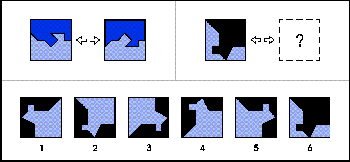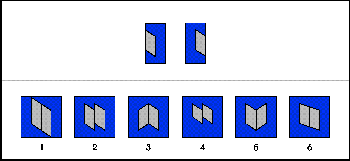Jack A. Naglieri, PhD, Achilles N. Bardos, PhD
Overview:The GAMA test (General Ability Measure for Adults) is a self-administered, timed test that uses abstract designs, shapes, and colors to help measure general ability. Normed on a census-based sample of 2,360 adults, it can be effective with a variety of populations and can be administered to individuals or groups. The GAMA IQ score helps estimate an individual's general intellectual ability and the 4 subtest scores provide additional information about the individual's performance
Age Range:Individuals 18 years and older
Administration:Paper-and-pencil
Scoring Option:Q-global™ web-based scoring, Q™ Local Software, Mail-in Scoring Service, or Manual Scoring
Reading Level:3rd Grade
Completion Time:25 minutes (timed: 66 items; 6 response options)
Telepractice:Tips on using this test in your telepractice
Publication Date:1997
The GAMA test (General Ability Measure for Adults) is a self-administered, timed test that uses abstract designs, shapes, and colors to help measure general ability. Normed on a census-based sample of 2,360 adults, it can be effective with a variety of populations and can be administered to individuals or groups. The GAMA IQ score helps estimate an individual’s general intellectual ability and the 4 subtest scores provide additional information about the individual’s performance.
How to Use This Test
The GAMA test can be used by clinical professionals and psychologists in a variety of settings, including:
- As part of a psychological evaluation when a brief tool is needed to help assess general cognitive ability
- When evaluating people who speak English as a second language or who read at a low level
- With special populations such as deaf adults, the elderly, and individuals with learning disabilities, mental retardation, or traumatic brain injury
- For neuropsychology and forensic evaluations
- For large-scale assessment (e.g. with correctional or military populations)
- In counseling and psychotherapy settings to help choose interventions that match a client’s intellectual ability
- For counseling to facilitate vocational decisions
Key Features
- Self-administered, 25-minute, timed test. Its brevity enables clinicians to include the test as part of a complete cognitive assessment.
- Administered individually or with groups.
- Highly correlated with other intelligence measures, the GAMA test helps provide convenience without sacrificing quality.
- The nonverbal format helps overcome language, cultural and educational barriers, making it useful with diverse populations.
- Requires less training for administrators than many other general abilities tests.
Test Items
The GAMA test’s nonverbal item content helps overcome language, cultural, and educational barriers.
The GAMA test design allows you to test people who were previously difficult to test. GAMA test items require a person to apply reasoning and logic to solve problems that exclusively use abstract design and shapes. This design minimizes the effects of knowledge, verbal expression, and verbal comprehension on test scores.
The GAMA test uses four types of test items and subscales:
- Matching
- Sequences
- Analogies
- Construction
Matching: Requires examination of the shapes and colors of stimulus to determine which response option is identical.

Sequences: Requires the analysis of the interrelationships of designs as they move through space.

Analogies: Involves the discovery of the relationships in a pair of abstract figures and the recognition of similar conceptual relationships in a different pair of figures.

Construction: Involves the analysis, synthesis, and rotation of spatial designs to construct a new figure.

GAMA Test Results Provide an Efficient Description of General Ability
An individual’s GAMA IQ test score is based on the four subtest scales scores. Using hand-scoring materials or computerized scoring, you will generate a graphic representation of the person’s total score with a 90% confidence interval. An Ability Classification (from Well Below Average to Very Superior) and a Percentile rank are also reported. Subtest scores include a classification, a deviation score, and Strength/Weakness indications.
Scales
The GAMA IQ score provides an estimate of general ability based on the scores on 4 subtest scales.
- Matching
- Analogies
- Sequences
- Construction
The subtest scores can also be analyzed to provide additional information about the individual’s performance.
Psychometric Information
The GAMA test was normed on a census-based sample of 2,360 adults stratified by age, gender, race or ethnic group, educational level, and geographic region. The sample was partitioned into 11 age groups. The age groups and sample sizes are listed below. In addition, studies were undertaken during the development of the GAMA test to enhance its usefulness with special populations such as deaf adults, adults with learning disabilities or traumatic brain injury, mentally retarded adults, and the elderly.
| Norm Group | Sample Size |
| 18 – 19 years | 265 |
| 20 – 24 years | 271 |
| 25 – 34 years | 310 |
| 35 – 44 years | 300 |
| 45 – 54 years | 274 |
| 55 – 59 years | 153 |
| 60 – 64 years | 104 |
| 65 – 69 years | 238 |
| 70 – 74 years | 219 |
| 75 – 79 years | 135 |
| 80+ years | 91 |
Report Option
Profile Report (Product Number 51510)
The report includes narrative and graphic information on the GAMA IQ score, based on the four subtest scores, as well as:
- A graphic representation of the respondent’s total score with a 90% t 95% confidence interval.
- An Ability Classification (from Well-Below-Average to Very-Superior) and a Percentile rank.
- The four subtest scores and a classification, a deviation score, and a Strength/Weakness indication for each subtest.
View a sample Profile Report.
Scoring and/or Reporting Options
Q-global™ Web-based Scoring and Reporting – Enables you to quickly assess and efficiently organize examinee information, generate scores, and produce accurate comprehensive reports all via the Web.
Q™ Local Scoring and Reporting Desktop Software – Enables you to score assessments, report results, and store and export data on your computer.
Mail-in Scoring Service – Specially designed answer sheets are mailed to Pearson for processing within 24–48 hours of receipt; results returned via regular mail.
Manual Scoring – Administer assessments on answer sheets and score them quickly yourself with an answer key.
Materials
GAMA Brochure (PDF- 105 KB)
Getting Started with the Q-global Training Series
View these brief training modules about Q-global:

Questions
Frequently asked questions follow. Click on a question to see the response.
Test Content
-
How reliable and valid is the GAMA test?
-
Were the GAMA items checked for bias between different groups?
Administration
-
Can I use the GAMA test with a client who speaks English as a second language?
-
Can I use the GAMA test for group administration?





